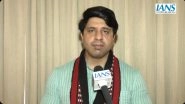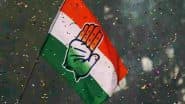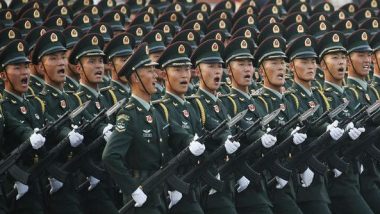Hong Kong, Jan 28: The military life is not for everyone, and that will become an increasing problem for the People's Liberation Army (PLA) in China. Although China's military had largely downsized from 2.3 million to 2 million personnel by the end of 2017, the onus is on being able to recruit the right caliber of soldier, sailor and airman.
A recent and important change to the PLA's recruitment processes is, therefore, seen as one way to alleviate this burden. In mid-January 2020, the PLA changed its conscription recruitment process from once a year to twice annually.
Now, new members will join the PLA via recruitment deadlines on March 1 and September 1 each year. According to the announcement on January 16, "Recruitment for the first half of the year will start in mid-February to the end of March, and the recruitment for the second half will run from mid-August to the end of September. China to Make Hospital with 1000 Beds in 10 Days to Treat Coronavirus Patients in Wuhan (Watch Video).
"As a corollary, the retirement of serving personnel will also change from once a year to twice. The official announcement stressed that "the total number of recruits will remain stable compared with previous years". Collin Koh, a research fellow at the Maritime Security Programme at the S Rajaratnam School of International Studies in Singapore, told ANI, "Regarding (this) recent change... I believe they wanted to ensure a seamless transition between the inflow of new recruits and demobilisation of active service personnel, thus creating no gaps that would mean some operational units could be facing manpower shortfalls for certain periods of time. This challenge, of course, affects training tempo, and also affects unit cohesion.
"Previously, recruitment used to occur only in August. Indeed, in 2013, the recruitment period moved to August from November in order to better synchronise with the graduation of college students each summer, making it easier to attract them straight into the military. The Military Service Law stipulates that conscripts must serve a period of two years.
All 18-year-olds are registered for selective compulsory military service, and each year about 10 million males reach military age, of which about 8 million are considered fit for service.Estimated annual quotas for the PLA are about 450,000, or about 22.5 per cent of its total manpower, of which most go to the ground force. Those who sign up are usually sufficient to cover requirements, resulting in "volunteer conscription".
Nonetheless, basic mathematics shows that, if the PLA recruits only once per year, then it must change close to half its enlisted force every year on average. This adds up to hundreds of thousands of soldiers joining and leaving the PLA every autumn. Obviously, this is a hugely disruptive process for the overall maintenance of combat levels, and the PLA endures an annual 3-4 month period in September-November in particular when its combat power is diminished.
Under the old scheme, field training reached its zenith in the summer as, by then, new personnel had completed their "boot camp" and had been serving with their respective units for a while.Now with a new recruitment period added in February, Cristina Garafola, a policy analyst at the RAND Corporation, tweeted, "This could really shake up the training cycle and readiness at the unit and other levels.
"The Military Recruitment Office supervises this conscription process, which operates more as a levy, and people can apply online via the National Military Recruitment Network. Unfortunately, no data is available on what proportion of recruits are compelled to serve and those who do so voluntarily.Nor is it clear how the two annual intakes will be proportioned, whether 50 : 50 or with a different weighting.
However, recruitment was made slightly easier by the slashing of 300,000 jobs as announced by Chairman Xi Jinping on September 3, 2015. Senior Colonel Ren Guoqiang, the Ministry of National Defence spokesman, described the change saying, "Under the premise of meeting annual military recruiting goals, the Chinese military wants to increase the frequency of military recruiting and reduce the quantity of single military recruiting, thus allowing a smooth flow of troops and always maintaining the military's high vigilance." He stressed this alteration "is of great significance for improving the enlistees' quality and training and enhancing the military's combat capability".
An important change also occurred in 2017, when the military began to directly recruit graduates from higher-learning institutions and desisted in doing so from senior high schools. Today, the focus remains on college graduates as the PLA seeks to become a high-tech and modern force.
Pointing out an important aspect to the recruitment change, Charlie Lyons Jones, a researcher in the Australian Strategic Policy Institute's (ASPI) Defence and Strategy Program, told ANI, "The challenges facing the PLA's ability to recruit and retain talent are not necessarily to do with its human resource management, but with pressures on China's labour force at large.
China's demographic profile is deteriorating rapidly, which is likely to make recruitment of talent a pressing issue for all sectors of the Chinese economy. As China's labour force shrinks but becomes better educated, the PLA must compete with the private and public sectors to position itself as providing a viable, fulfilling career so that it can attract the best talent from Chinese society.
"Lyons Jones continued, "For the officer corps, attracting cutting-edge scientific talent is likely to become a priority for the PLA as more sophisticated weapons platforms come online in the coming years. Engineering graduates from Tsinghua or Beihang need to believe that the skills they developed will be better used in the PLA than in other sectors of China's economy.
More importantly, high school students who have the marks to go to these elite civilian universities need to feel as though going to the Naval University of Engineering or the Rocket Force University of Engineering would be a good use of their talents. Winning over those hearts and minds will be crucial for the PLA in the medium term."
"But, for such talent to be won in the medium term, the gap in quality between China's civilian and military universities needs to be narrowed in the short term. Military-civil fusion, a policy promoted by General Secretary Xi Jinping, will help relatively PLA scientists leverage expertise from China's growing cadre of civilian researchers through more frequent research collaborations. Whether or not that leads to China's top scientific talent going to the PLA's best engineering universities remains to be seen," Lyons Jones said.
While the PLA does not currently have a shortage of recruits, it relaxed physical standards somewhat to attract better-qualified personnel. Yet the life of a PLA serviceman or woman is not easy. They can be posted far from home - often in inhospitable places such as Tibet, Inner Mongolia or the South China Sea. Their tasks are demanding and the military discipline they face could only be described as stern. Such a life is unattractive to many, especially if more money can be made in a cushier private-sector job.
Indeed, the case of university student Zhang Moukang from Hainan was publicised in the PLA Daily as a stark warning to others. After a month in uniform, he decided that he wanted to quit the PLA. Different penalties were promptly slapped on him before he was dismissed, including two-year bans on foreign travel, domestic plane, long-distance train and bus journeys, buying property, enrolling in a college or secondary school, opening a business, or getting a loan or insurance.
Nor will the publicly shamed Zhang ever work for the government or a state-owned enterprise. He was also fined USD 4,000 and required to reimburse USD3,750 to the PLA for expenses incurred. The PLA Daily report concluded, "Zhang Moukang has been unable to adapt himself to the military life for fearing hardships and fatigues. Despite the troops' patient exhortation, he still persisted in dropping out.
"The PLA must walk a fine line between maintaining an attractive public image and yet deterring bad behaviour and a lack of respect for military discipline.China's handling of approximately 57 million veterans also has a bearing on recruitment. Despite Xi setting up a Ministry of Veterans Affairs, widespread disenchantment among veterans over their lack of welfare and fair treatment continues. Veterans have held numerous rallies demanding better retirement benefits, but authorities are usually more concerned about silencing social unrest than in solving the root issue.
As long as these veterans' issues continue to fester, this is another disincentive for young people to join the military. The PLA must, therefore, offer and enforce better demobilisation policies with more generous benefits.Lyons Jones of ASPI also pointed out, "The PLA is bringing online weapons platforms of increasing sophistication. Operating the combat systems that underpin these platforms will require enlisted soldiers to be reasonably well educated even before they begin the PLA's basic training.
Given China's massive educational disparities between regions, it is unclear whether or not the PLA can recruit enlisted personnel at scale without compromising on educational standards. "Koh in Singapore gave the example of aviators for China's burgeoning aircraft carrier fleet. "The bigger question is, is it sustainable or possible for China to come up with a critical mass of qualified personnel...It is not just about the sailors. The thing for a carrier is naturally about the aviators. They can probably build as many J-15s, or the new follow-up fighter, for service as a carrier-borne aviation capability, but are they able to recruit enough folk? "Koh noted that the PLA Navy Air Force is now actually looking to attract teenagers, signalling that the force recognises the need to start young.
However, Koh pointed out that carrier-borne operations are dangerous, with an unknown number of Chinese pilots already dying. The Singaporean academic recalled the Chinese saying, "Good sons do not become soldiers," whereby there is reluctance in the Chinese psyche to risk your life for nothing.This recruitment problem is common to the whole PLA, as it faces rampant employment competition with the private sector.
"Young Chinese will prefer to work for the private sector earning better pay than to risk their lives," Koh mused.The PLA also has a special recruitment drive for females. Thus, on January 21, Xinhua reported that the PLA had started 2020's female recruitment drive "mainly among college students". This first phase of recruitment ends on February 15, while the second phase occurs from June 26 to August 15.
According to Xinhua, "The recruitment includes procedures of signing up, physical examination and political assessment. Family members of martyrs and soldiers would be given priority."The PLA is also seeking to fill non-combat technical or managerial posts with civilian personnel. In August 2018, it was reported that more than 140,000 candidates for such posts sat a written exam in 31 provinces.
This was the first time such an exercise had been held, with candidates jostling for 9,297 positions. Normally active servicemen perform these jobs, so freeing them up for combat-oriented tasks will benefit PLA effectiveness.Lyons Jones concluded saying, "Force planners on the Central Military Commission are faced with this question: Can China recruit the talent needed to develop a PLA that is both big in size and high in quality? The range of possible answers to that question is likely to shrink as China's demographics begin nibbling away at the PLA's capability."













 Quickly
Quickly












